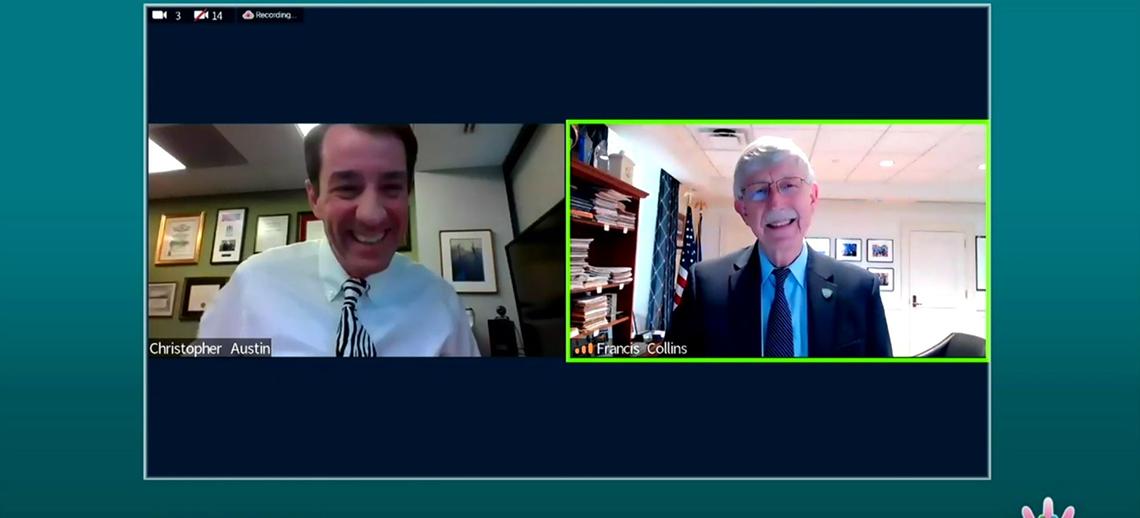‘Cumulatively Common’
Rare Diseases Are a Public Health Issue

Rare diseases are a public health issue, said NCATS director Dr. Christopher Austin during NIH’s annual—and first virtual—observance of Rare Disease Day.
“Although they are individually rare, they are cumulatively common,” he said. People who have them make up about eight percent of the global population—that’s about the same proportion who have diabetes. “Everybody knows diabetes is a public health problem, but rare diseases are not appreciated as being a public health problem.”
Researchers now know the molecular basis of almost 7,000 rare diseases, or conditions that each affect fewer than 200,000 people in the United States. Austin said while that’s something to be celebrated, especially when it comes to finding a diagnosis, the sad fact is treatments haven’t followed at the same pace as disease gene discovery.
Unfortunately, fewer than 500 rare diseases have an FDA-approved treatment. At the current rate, it will be over 2,000 years before there is a treatment for every rare disease.
“The current development of new treatments takes far too long and fails far too often and is therefore far too expensive,” Austin said. “Translational science is the key to improving this record.”
Austin called for “disruptive change.” At NCATS, researchers are now trying to identify similarities across diseases in order to develop treatments for multiple disorders at one time, develop models that better predict a person’s reaction to treatment and design clinical trials for smaller populations.
Rare Disease Day 2021 featured updates from researchers, stories from patients and their families and panel discussions.
“We’ve got a long way to go to fill in that big gap between our diagnostic and therapeutic abilities,” agreed NIH director Dr. Francis Collins.
Many of the FDA-approved treatments for rare diseases only address symptoms. While these treatments are encouraging, they aren’t cures. Collins promised, “We’re not going to rest until we find those.”
Collins’ own lab at NIH studies progeria, a rare and fatal pediatric disease, characterized by dramatic, rapid aging, beginning in childhood. In November 2020, the FDA approved a treatment for progeria. While the drug does extend the life of patients, “it’s not the end of the story,” Collins explained. His lab is now working on other ways to attack the disease using RNA-based approaches and DNA editing technologies.
NIH supports several networks to better understand rare diseases, including NCI’s My Pediatric and Adult Rare Tumor Network and the NCATS Rare Disease Clinical Research Network. Clinical Center scientists, too, have several studies on rare diseases underway.
Some of today’s therapeutic interventions “we didn’t even dream about in 2011,” noted Collins. The gene editing system CRISPR is one of them.
“This is an opportunity to figure out how we could take this approach—which has the potential of searching out every possible place in the genome where there’s a misspelling in a tissue and delivering a gene editing apparatus to try and fix that,” Collins said. “That sounds like it would be straightforward, but it’s not. The ability to do that safely and effectively requires you to have the appropriate delivery systems in place.”
To speed up gene editing technologies, the NIH Common Fund’s Somatic Cell Genome Editing program is working to improve approaches to help reduce the burden of diseases caused by genetic changes. Additionally, the NCATS-led Platform Vector Gene Therapy (PaVe-GT) seeks to make it easier to start clinical trials by using the same gene delivery system and manufacturing methods for multiple rare disease gene therapies.
NIH is also working with industry to launch the Bespoke Gene Therapy Consortium, which is dedicated to making gene therapy a reality for people with genetic diseases affecting populations too small to be viable from a commercial perspective.
“We’re in a pretty good place here to be able to see a real change in the approach and the ability to scale to lots of disorders,” Collins said.
The Covid-19 pandemic has shown it’s possible to develop new technologies, such as vaccines and diagnostic testing, faster than ever.
“We’ve done things that most people wouldn’t have guessed could have happened in just a year,” he said. “We can apply some of those lessons as we go forward.”
Despite pandemic-related restrictions, patients and researchers must continue to work together in new and innovative ways.
“We can do things together that are phenomenal and breathtaking,” Collins concluded. “We have been, we are, and we aim to continue to be not just the National Institutes of Health, but the National Institutes of Hope.”
